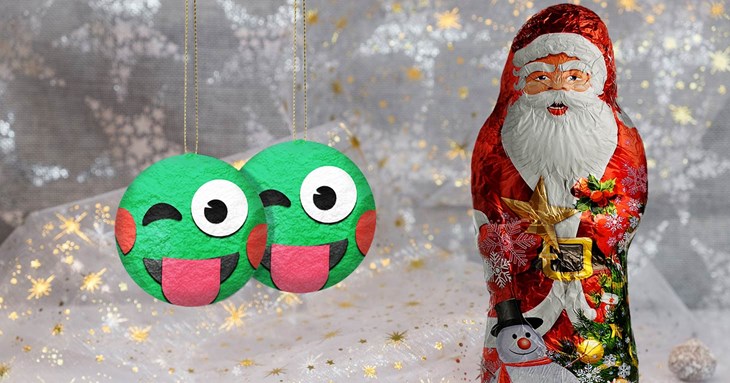Denis the Dustcart would like to talk about confectionery wrappings
Published: 9 December 2020

In his regular feature, Denis the Dustcart would like to talk about confectionery wrappings and what to do with them over the Christmas period.
You can follow Denis on his Facebook page to keep up with information about Recycling issues.
You know it’s nearly December when you’ve eaten all the Christmas chocolates you bought for your tree in October.
Today I want to talk about confectionery wrappings.
Before I start, though, I’d like to say that I’m not seeking to encourage the demise of anyone’s festive chocolate ingesting – especially not after this year of all years. I’ll be doing quite a bit of it myself. It’s just that, wow, we eat a lot of chocolates.
It’s what the packaging contains that usually has the greater impact on our planet. Not much of the choccie available to us in pretty festive wrappings is of the ethical kind.
A friend of mine gifts homemade liqueur chocolates each year, crafted from ethical chocolate. They have to be eaten quickly, though, because they aren’t individually wrapped. Not that I mind about that, of course.
I’d be interested to hear what you do for eco festive treats. Write your ideas in the comments.
In this piece, however, I’m going to focus on packaging.
There are three types of wrappings that most commercial chocolate producers use: laminated plastic foil, cellophane and aluminium foil. Some producers now wrap individual chocolates a home-compostable cellulose, though how much of these wrappers actually get composted is another matter.
When it comes to recycling, there is one basic rule to remember: if it fails the scrunch test – i.e. if it springs open after being scrunched up – it can’t be recycled. So that’s all the millions of little torn open plastic wrappings, many of which get left in the box to later inflict upon us the disappointment of realising all our favourites are in fact just ‘empties’.
I’ve often wondered why companies never turned away from foil towards plastic for their seasonal ‘character’ confectionery, like they did for many of the chocolate bars you can buy all year round. I can only assume it’s for the sake of their customers’ sense of magic and tradition; a sparkly, foil-wrapped Father Christmas looks a lot more Christmassy than one encased in plastic.
Plastic is used so much because it’s lighter in transport and keeps food fresh on the shelves for longer – we all know that. It has revolutionised how we consume for that very reason – many would say for the worse. More can be shipped further, stored for longer and sold everywhere more cheaply and for greater profits.
But the plastic that wraps chocolate is bad plastic. Non-recyclable plastic.
We are told by retailers and producers that we can recycle the attractive ‘traditional’ foil from our chocolate snowmen and Father Christmasses, and of course we should do that. It’s highly valuable. To be recycled, however, it needs first to be picked off the recycling line, and for that to happen it needs to be balled up to about the size of a tennis ball.
Does being recyclable make packaging ‘green’, though?
Aluminium is endlessly recyclable, but the production of the virgin material comes at enormous planetary cost. Were it to be produced in the same quantities as plastic then the environmental and ecological harm caused would be pretty significant.
Turning raw bauxite into aluminium through the processes of mining, refining and smelting uses incredible amounts of fuel, electricity, water and other ‘resources’, resulting in, among other harmful things, copious greenhouse gas emissions. The biodiversity loss, as a consequence of swathes of land being given over to the mining of bauxite, is pretty intense.
Let’s take all the millions of little chocolate eggs (OK, I’m veering away from Christmas a little bit, but let’s face it: Easter eggs will be in the shops come 2nd January). Two eggs for £1, so you ‘may as well buy two’. These aren’t meant not to be taken home, but consumed on the go.
How much of that foil is actually recycled? Most of it will get scrunched into a pip and thrown in a street bin. Even if the pip does make it home in a pocket, how likely is anyone to then unpick it and wrap it into a ball built from all the other little bits of foil that have entered their life?
Even the most ardent recycler will find the small amounts of foil infuriatingly difficult to scrunch together into a ball big enough not to fall through recycling machinery and to be picked off a conveyor by people wearing heavy gloves. You need to encase them in larger pieces of foil.
And is the foil even made from recycled material in the first place? Sometimes it is. But the less we recycle, the more we have to make from scratch.
Isn’t it the wrong way around to put all the emphasis on whether something is recyclable? Shouldn’t we be asking why we produce waste rather than focussing mainly on how we can deal with that waste?
Waste is an inevitable consequence of consumption. The more our demand for confectionery is encouraged, the more we demand. The more we buy, the more is made.
Some may point towards food waste as a reason for using single-use air-tight packaging, but this isn’t really a valid argument for confectionery that is mass-production for the sake of maximum profit. Foil or cheap, thin, highly efficient plastic allows more to be sold, and feeding the consumerist habit only results in the greater production of waste overall.
While demand for the goods exists and is encouraged, there will be no backing away from single-use packaging. It will be interesting to see how producers move to solve the equation:
Product Freshness + Continued Profitability + Sustainability = ?
